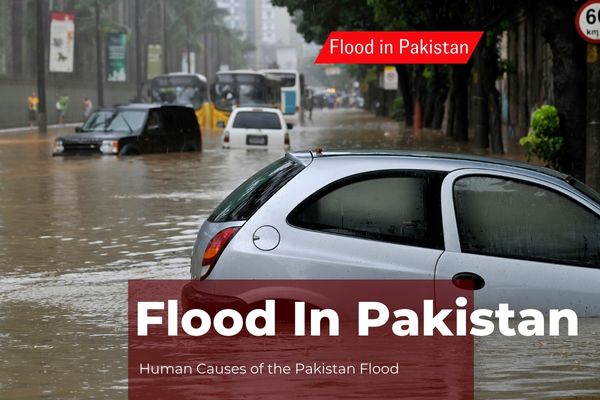Deadliest Flood in Pakistan
The causes of the Deadliest Flood in Pakistan are many. A thunderstorm is a monotonous event in Pakistan during the rainy season but In July 2010, the power of thunderstorms increased vastly in the mountainous zone of Azad Kashmir and KPK which caused a flash flood in the upriver area. Due to incredible runoff, prolonged streams of monsoon were generated, triggering the destructive and Deadliest floods in Pakistan that spread all over the country. All backwaters of Pakistan, exclusively cities, towns, and villages sideways River Kabul, River Indus, and River Swat suffered unbelievable devastations. In July 2010 flood in Pakistan highlighted the magnitude of the catastrophe in the world.
Causes of flood in Pakistan.
Physical Causes of the Deadliest Flood in Pakistan
- The main cause of the 2010 Deadliest Flood in Pakistan flood was recorded breaking monsoon rains that hit parts of Pakistan. In Peshwar, 312mm of rainfall in 24 hours that the broken record previous rainfall. The previous highest rainfall was 187mm in 24 hours.
- Climate change has been reasoned to severe rainfall and Pakistan officials called it ‘the flood of the century.
- Deforestation is an issue of many floods due to reduced infiltration and increased surface run-off.
5 Biggest Landslide: পৃথিবীর ইতিহাসের সবচেয়ে ভয়ঙ্কর পাঁচটি ভূমিধস
Human Causes of the Deadliest Flood in Pakistan
- Pakistan created the Federal Flood Commission which was in charge of creating and managing effective flood defenses. But this sector has not upgraded to respond to the devastating situation of flood. As a result, Pakistan was under-prepared for a major rainfall event.
- The building quality of settlements close to the river is poor and disposed to collapse during floods which emphasize the problem.
- Role of Urbanization in increasing flood hazards
- Unplanned urbanization especially in the mountain areas.
- Lack of plane land in mountainous areas. The population selects the banks of basins of the rivers for their dwelling construction which are usually in flood hazard zones.
- Role of the high rate of sedimentation in flood
- Tarbela Dam reservoir is the only storage that maintains the flooding water inflows of the northern part of Pakistan. But the storage capacity of the reservoir is subsided by the high rate of sedimentation and its approximately 35% since its construction in 1975. For this reason, Munda Dam, Diamir Basha Dam, and other dams are required to be constructed through national harmony for long-term planning to control floods.
Lack of Awareness
- High ill- literacy rate the predominant in the mountainous area
- The people don’t follow the flood notices allotted by the Government. They don’t evacuate the flood-prone zones until the flood water enters the houses and there is no time left to leak.
Impacts of the Deadliest Flood in Pakistan
-
Impact on Agriculture, Crops and Livestock
According to the FAO agricultural assessment report, the floods caused damages of unprecedented scale to agriculture crops, livestock, fisheries, and forestry and destroyed primary infrastructure such as tube wells, water channels household storages, houses, animal sheds, personal seed stocks, fertilizers and agricultural machinery. It is estimated that over 2 million hectares of standing crops were either lost or damaged and over 1.2 million head of livestock (excluding poultry) died due to the flood. Between 60 and 88 percent of the farming households reported losses of more than 50 percent of their major crops: rice, vegetables, cotton, sugar, and fodder. These households were mostly located in Punjab and Sindh.
-
Damages to the power sector
Power sector infrastructures were severely damaged in the flood-affected areas. Major damages were recorded in the province of KPK. Hydro power plants of Jagran (30 MW) and Malakand-III (81MW) were flooded. Powerhouses of about 2000 MW including the KAPCO plant and the Muzaffargarh plant were partially shut down due to expected flood hits and unavailability of fuel as road and railway infrastructure was severely damaged.
-
Hydrological Aspects of Deadliest Flood in Pakistan
The prevailing hydrological cycle in the country is composed of two components which provide water through snow and rainfall. During the hot months of summer, sometimes the snow sheet is capable to generate more than 1,00,000 cusecs runoff only for a 10C rise in temperature in the snow-covered areas of Skardu. The other component of the hydrological cycle, rainfall has two prominent spells in Pakistan, one during monsoon and the other during winter rains mostly controlled by western winds. During July 2010 the major storage reservoirs, Tarbela & Mangla were already on a rising leg when the prolonged monsoon started in the last week of July.
The destructive floods of 2010 in Pakistan are predominantly caused by the effects of prolonged monsoon rainfalls. The hazards caused by these floods are enormously increased due to large-scale construction and blockage of the river’s regimes. The role of big reservoirs in controlling and regulating floods, such as the Tarbela Dam reservoir is ended due to the loss of their storage capacity. Flood hazards zonation mapping should be carried out in the light of the flood route of the year 2010 and all types of settlements and construction should be stopped forthwith in all river regimes.
Read More:
বিহার ভূমিকম্প (১৯৩৪) Earthquake in Bihar 1934 বাংলাদেশের ইতিহাসে সবচেয়ে প্রলয়ঙ্কারী পাঁচটি ঘূর্ণিঝড় Cyclone
